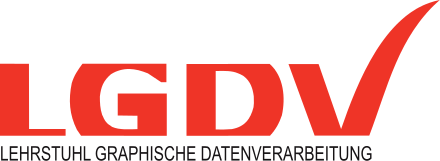- Adaptive stray-light compensation in dynamic multi-projection mapping
- Adaptive Temporal Sampling for Volumetric Path Tracing of Medical Data
- Analytic Displacement Mapping using Hardware Tessellation
- Anisotropic Surface Based Deformation
- Auto-Calibration for Dynamic Multi-Projection Mapping on Arbitrary Surfaces
- Automated Heart Localization in Cardiac Cine MR Data
- Demo of Face2Face: Real-time Face Capture and Reenactment of RGB Videos
- Enhanced Sphere Tracing
- Evaluating the Usability of Recent Consumer-Grade 3D Input Devices
- Face2Face: Real-time Face Capture and Reenactment of RGB Videos
- FaceForge: Markerless Non-Rigid Face Multi-Projection Mapping
- FaceInCar: Real-time Dense Monocular Face Tracking of a Driver
- FaceVR: Real-Time Facial Reenactment and Eye Gaze Control in Virtual Reality
- GroPBS: Fast Solver for Implicit Electrostatics of Biomolecules
- Grundsätzliche Überlegungen zur Edition des Bestandes an Münzen der FAU als frei zugängliche Datenbank im WWW
- HeadOn: Real-time Reenactment of Human Portrait Videos
- Hierarchical Multi-Layer Screen-Space Ray Tracing
- Hybrid Mono-Stereo Rendering in Virtual Reality
- Interactive Model-based Reconstruction of the Human Head using an RGB-D Sensor
- Interactive Painting and Lighting in Dynamic Multi-Projection Mapping
- Learning Real-Time Ambient Occlusion from Distance Representations
- Low-Cost Real-Time 3D Reconstruction of Large-Scale Excavation Sites using an RGB-D Camera
- Multi-Layer Depth of Field Rendering with Tiled Splatting
- Multi-Resolution Attributes for Hardware Tessellated Objects
- Real-time 3D Reconstruction at Scale using Voxel Hashing
- Real-time Collision Detection for Dynamic Hardware Tessellated Objects
- Real-time Expression Transfer for Facial Reenactment
- Real-time Local Displacement using Dynamic GPU Memory Management
- Real-Time Pixel Luminance Optimization for Dynamic Multi-Projection Mapping
- Reality Forge: Interactive Dynamic Multi-Projection Mapping
- Robust Blending and Occlusion Compensation in Dynamic Multi-Projection Mapping
- Shape Adaptive Cut Lines
- Spherical Fibonacci Mapping
- State of the Art Report on Real-time Rendering with Hardware Tessellation
- Stray-Light Compensation in Dynamic Projection Mapping
- Visualization and Deformation Techniques for Entertainment and Training in Cultural Heritage
- VolumeDeform: Real-time Volumetric Non-rigid Reconstruction
